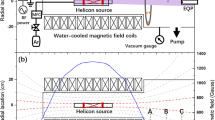Abstract
We report on the physical attributes of an argon-hydrogen plasma and the effects that induced changes in these attributes have on the physical and electrical characteristics of the plasma itself. Changes in the plasma conditions of these argon-hydrogen plasmas due to variations in microwave power, DC biasing, gas concentrations, and pressures were measured. We determined that increasing the hydrogen flow increases the sheath potential of the plasma, thereby increasing the arrival energy of ions at the surface of a sample placed in the plasma. Even with the decrease in plasma density from an increase in hydrogen input flow, we found the ion current is maintained in the predominately hydrogen plasma and is likely compensated by the high velocity and long mean free path of the hydrogen. We also observed that increasing total pressure also results in hydrogen ions dominating the total number of ions reaching the Langmuir probe and therefore the sample during processing. Last, a model based on the ion/electron energy ratio was developed and used to determine the relative ion concentrations of hydrogen and argon ions.
Similar content being viewed by others
References
P. O’Dette, G. Tarnowski, V. Lukah, M. Krueger, and P. Lovecchip, J. Electron. Mater. 28, 821 (1999).
A.J. Stoltz, J.D. Benson, Mason Thomas, P.R. Boyd, M. Martinka, and J.H. Dinan, J. Electron. Mater. 31, 749 (2002).
A.J. Stoltz, J.D. Benson, P.R. Boyd, J.B. Varesi, M. Martinka, A.W. Kaleczyc, E.P. Smith, S.M. Johnson, W.A. Radford, and J.H. Dinan, J. Electron. Mater. 32, 692 (2003).
E.P.G. Smith, J.K. Gleason, L.T. Pham, E.A. Patten, and M.S. Welkowsky, J. Electron. Mater. 32, 816 (2003).
E.P.G. Smith et al., J. Electron. Mater. 33, 509 (2004).
J. Baylet et al., J. Electron. Mater. 33, 690 (2004).
R.C. Keller, H. Zimmerman, M. Seelmann-Eggebert, and H.J. Richter, J. Electron. Mater. 25, 1270 (1996).
R.C. Keller, H. Zimmerman, M. Seelmann-Eggebert, and H.J. Richter, J. Electron. Mater. 26, 542 (1997).
E. Neyts, M. Uan, A. Bogaerts, and R. Gijbels, J. Appl. Phys. 93, 5025 (2003).
M. Elwenspoek and H.V. Jansen, Silicon Micromachining (Cambridge, United Kingdom: Cambridge University Press, 1998), pp. 212–233.
Michael A. Lieberman and Allan J. Lichtenberg, in Principles of Plasma Discharges and Materials Processing (New York: John Wiley & Sons, Inc., 2004), pp. 154–190.
Francis F. Chen and Jane P. Chang, Plasma Diagnostics (New York: Kluwer Academic/Plenum Publishers, 2003), pp. 75–97.
James E. Stevens, Electron Cyclotron Resonance Plasma Sources in High Density Plasma Sources, ed. Oleg A. Popov (Park Ridge, NJ: Noyes Publications, 2005), pp. 312–379.
Michael A. Lieberman and Allan J. Lichtenberg, Principles of Plasma Discharges and Materials Processing (New York: John Wiley & Sons, Inc., 2004), pp. 412–449.
J.D. Benson, A.J. Stoltz, J.B. Varesi, L.A. Almeida, E.P.G. Smith, S.M. Johnson, M. Martinka, A.W. Kaleczyc, J.K. Markuna, P.R. Boyd, and J.H. Dinan, J. Electron. Mater. 34, 726 (2005).
K. Suzuki, K. Ninomiya, S. Nishimatsu, and S. Okudaira, J. Vac. Sci. Technol. B, 3, 1025 (1985).
C.R. Eddy, Jr., D. Leonhardt, S.R. Douglass, V.A. Shamamian, B.D. Thoms, and J.E. Butler, J. Vac. Sci. Technol. A 17, 780 (1999).
Seongsoo Jang and Wonjong Lee, J. Vac. Sci. Technol. A 19, 2335 (2001).
B. Chapman, Glow Discharge Process (New York: John Wiley & Sons, 1980), pp. 49–76.
John B.O. Caughman II and Willam M. Holber, J. Vac. Sci. Technol. A 9, 3113 (1991).
K. Shirai, T. Iizuka, and S. Gonda, Jpn. J. Appl. Phys. 28, 897 (1989).
Author information
Authors and Affiliations
Rights and permissions
About this article
Cite this article
Stoltz, A.J., Sperry, M.J., Benson, J.D. et al. A langmuir probe investigation of electron cyclotron resonance argon-hydrogen plasmas. J. Electron. Mater. 34, 733–739 (2005). https://doi.org/10.1007/s11664-005-0012-x
Received:
Accepted:
Issue Date:
DOI: https://doi.org/10.1007/s11664-005-0012-x



